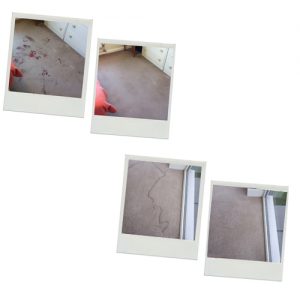How To Remove Stains From Carpets
I’ve been doing an unusual amount of stain removal over the last few weeks. Pet stains, blood, red wine, tea, coffee, lily pollen, you name it I seem to be removing it!
So I thought it would be a good idea to write something helpful on the subject of stain removal. And here it is…
To begin with there are 4 basic principles regarding stain removal:
1. Absorb it. Rather than panic and pour on whatever cleaning product comes to hand, the first step should always be ABSORB.
Use talcum powder, powderdam, paper tissues, towels. Absorb as much as possible before attempting anything else.
2. Dissolve it. Residues that can’t be absorbed need to be dissolved. However, different substances have different solubility in solvents. for example, beetroot juice is solvent in water, while circumin colouring in turmeric dissolves in alcohol, so you’ll need to know which substance dissolves in what solvent.
3. Use a detergent. Fatty stains like gravy won’t dissolve in water. You’ll need to use a detergent. Detergents change the surface tension of water so that it can flow freely into fabrics The detergent also forms a link between the stain particles and the water, assisting removal. Always rinse detergents out completely afterwards.
4. Chemical Reaction. If steps 1-3 don’t work, it’s a chemical reaction that’s needed. Agents such as enzymes and bleaches bring about chemical reactions. Bleaches take out molecules rendering the stain invisible. Enzymes break down the bonds that hold amino acids in proteins. This makes them more easily removed in water and rinsed away.
10 Things you should always do to a stain.
1. Act quickly. The faster you deal with it, the greater the chance of it removing. Stains can become permanent over time. Also accept that some stains will not come out.
2. Blot / Absorb thoroughly. Use talcum powder, cornflour, paper towels, and terry towels to absorb as much stain as possible first.
3. Lift. Remove any ‘lumps’ using a spoon or blunt edge of a knife. On powdery stains use sticky tape wrapped around your fingers.
4. work from the outside in. you’ll avoid spreading the stain.
5. If you can, also treat and rinse from the other side (backing) of the stained item.
6. Know the textile you’re working on. Is it dry clean only? Does it need special products, or certain products must be avoided?
7. Read the instructions (and follow) of any products you decide to use.
8. Test first. Test your products in an inconspicuous area for colour loss / colour change / or texture change.
9. Rinse out any products used. Never leave them in the fabric.
10. Dry the item without using heat. Air movers, fans, dehumidifiers and ventilation are the best means of quickly drying a stained area. Don’t be tempted to use heat or you may fix any remaining traces of the stain.
11. BONUS TIP. If you’re unsure how to proceed, DON’T just wade in. It’s easy to make things worse. Call me for advice on 01304 381165, or email me a acscarpetclean@gmail.com. I’ll give you professional advice and, if you wish, look at the problem for you.
12. SECOND BONUS TIP. Always have your carpets and upholstery treated with scotchgard stain protector. It doesn’t affect the colour, or the feel of fabrics, but I daily see it make the difference between stains coming out and stains not coming out. All my carpets and upholstery are scotchgarded, and I would never be without it, it’s that good.



